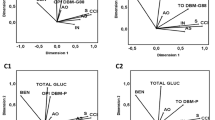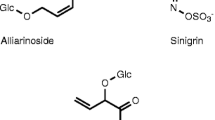Abstract
The conditional role of cucurbitacins as phytosteroid supplements, cholesterol precursors, or ecdysteroid antagonists in the spotted cucumber beetle, Diabrotica undecimpunctata howardi, was investigated in two ways: by comparing larval survival and growth rate on cucurbitacin-rich and cucurbitacin-poor squash cultivars of Cucurbita pepo and by manipulating the presence of cholesterol, phytosteroids, and cucurbitacins in an artificial diet and examining the effects on adult survival and fecundity. Larvae that developed on cucurbitacin-rich roots grew significantly faster and survived as well as larvae on cucurbitacin-poor roots. There was no evidence, however, that adults could substitute cucurbitacins in vital phytosteroid roles. Beetles reared on a cucurbitacin-rich, phytosteroid-poor diet laid significantly fewer eggs and died significantly younger than beetles with a full complement of dietary phytosteroids and also laid fewer eggs than beetles with no access to phytosteroids in their adult diet. The data are consistent with the hypothesis that, when the side chain of dietary cucurbitacins can be successfully hydrogenated, these compounds play a nutritional role as substitutes or precursors for structural steroids. In contrast, when the carbon–carbon double bond cannot be hydrogenated, cucurbitacins may become antagonists at ecdysteroid receptors, negatively affecting beetle fitness.
Similar content being viewed by others
REFERENCES
Andersen, J. F., Plattner, R. D., and Weisleder, D. 1988. Metabolic transformations of cucurbitacins by Diabrotica virgifera virgifera Leconte and D. undecimpunctata howardi Barber. Insect Biochem. 18:71-77.
Bernays, E. 1994. Plant sterols and host-plant affiliations of herbivores, pp. 45-57, in E. A. Bernays (ed.). Insect-Plant Interactions, Vol. IV. CRC Press, Boca-Raton, Florida.
BopprÉ, M. 1984. Redefining “pharmacophagy”. J. Chem. Ecol. 10:1151-1154.
Bownes, M., and Redfern, C. P. F. 1985. Insect metamorphosis and its hormonal control, pp. 157-173, in M. Balls and M. Bownes (eds.). Metamorphosis. Clarendon Press, Oxford.
Briers, T., and Huybrechts, R. 1984. Control of vitellogenin synthesis by ecdysteroids in Sarcophaga bullata. Insect Biochem. 14:121-126.
Clark, A. J., and Bloch, K. 1959. Conversion of ergosterol to 22-dehydrocholesterol in Blattela germanica. J. Biol. Chem. 234:2589-2593.
Clayton, R. B. 1964. The utilization of sterols by insects. J. Lipid Res. 5:3-19.
DeHeer, C. J., and Tallamy, D. W. 1991. Cucumber beetle larval affinity to cucurbitacins. Environ. Entomol. 20:775-788.
Dinan, L., Whiting, P., Girualt, J., Lafont, R., Dhadialla, T. S., Cress, D. E., Mugat, B., Antoniewski, C., and Lepesant, J. 1997a. Cucurbitacins are insect steroid hormone antagonists acting at the ecdysteroid receptor. Biochem. J. 327:643-650.
Dinan, L., Whiting, P., Sarker, S. D., Kasai, R., and Yamasaki, K. 1997b. Cucurbitanetype compounds from Hemsleya carnosiflora antagonize ecdysteroid action in the Drosophila melanogaster BII cell line. Cell. Mol. Life Sci. 53:271-274.
Downer, R. G. H. 1978. Functional role of lipids in insects, pp. 57-81, in M. Rockstein (ed.). Biochemistry of Insects. Academic Press, New York.
Dumser, J. B. 1980. The regulation of spermatogenesis in insects. Annu. Rev. Entomol. 25:341-369.
Ferguson, J. E., Metcalf, R. L., and Fischer, D. C. 1985. Disposition and fate of cucurbitacin B in five species of diabroticites. J. Chem. Ecol. 11:1307-1321.
Fristrom, J. W., Raikow, R., Petri, W., and Stewart, D. 1970. In vitro, evagination and RNA synthesis in imaginal discs of Drosophila melanogaster, pp. 381-401, in E. W. Hanly (ed.). Problems in Biology: RNA in Development. University of Utah Press, Salt Lake City, Utah.
Fristrom, J. W., Natzle, J., Doctor, J., and Fristrom, D. 1985. The regulation of a developmental sequence during imaginal disc metamorphosis pp. 162-180, in M. Ball and M. Bownes (eds.). Metamorphosis. Clarendon Press, Oxford, U.K.
Guss, P. L., and Kryson, J. L. 1973. Maintenance of the southern corn rootworm on a dry diet. J. Econ. Entomol. 66:352-353.
Hagedorn, H. H. 1985. The role of ecdysteroids in reproduction, pp. 205-262, in G. A. Kerkut and L. I. Gilbert (eds.). Comprehensive Insect Physiology, Biochemistry and Pharmacology, Vol. 8. Pergamon Press, Oxford, U.K.
Hagedorn, H. H. 1989. Physiological roles at hemolymph ecdysteroids in the adult insect, pp. 279-289, in J. Koolman (ed.). Ecdysone. Theime Medical Publishers, New York.
Halaweish, F. T., and Tallamy, D. W. 1993. Quantitative determination of cucurbitacins by high performance liquid chromatography and high performance thin layer chromatography. J. Liq. Chromatogr. 16:497-511.
Hirsh, I. S., and Barbercheck, M. E. 1996. Effects of host plant and cucurbitacin on growth of larval Diabrotica undecimpunctata howardi. Entomol. Exp. Appl. 81:47-51.
Ikekawa, N. 1983. Sterol metabolism in insects and biosynthesis of ecdysone in the silkworm. Experientia 39:466-472.
Ikekawa, N. 1985. Structures, biosynthesis and function of sterols in invertebrates, pp. 199-230, in H. Danielson and J. Sjovall (eds.). Sterols and Bile Acids. Elsevier, Amsterdam.
Karlson, P., and Hoffmeister, H. 1963. Zur biogenese des Ecdysons, I. umwandlung von Cholesterin in Ecdyson. Z. Physiol. Chem. 331:298-300.
Lanot, R., Dorn, A., GÜnster, B., Thiebold, J., Laqueux, M., and Hoffman, J. A. 1989. Functions of ecdysteroids in oocyte maturation and embryonic development of insects, pp. 262-270, in J. Koolman (ed.). Ecdysone. Thieme Medical Publishers, New York.
Lavie, D., and Glotter, E. 1971. The cucurbitacins, a group of tetracyclic triterpenes. Fortsch. Chem. Org. Naturst. 29:307-356.
Lomberk, H. A. 1999. Curcurbitacin phagostimulation of diabroticite larvae. MS thesis. University of Delaware, Newark, Delaware.
Mandaron, P. 1970. Developpement in vitro de disques imaginaux de la drosophile. Aspects morphologiques et histologiques. Dev. Biol. 22:298-320.
Metcalf, R. L., Metcalf, R. A., and Rhodes, A. M. 1980. Cucurbitacins as kairomones for diabroticite beetles. Proc. Natl. Acad. Sci. U.S.A. 17:3769-3772.
Miro, M. 1995. Cucurbitacins and their pharmacological effects. Phytother. Res. 9:159-168.
Nishida, R., and Fukami, H. 1990. Sequestration of distasteful compounds by some pharmacophagous insects. J. Chem. Ecol. 16:151-164.
Nishida, R., Yokoyama, M., and Fukami, H. 1992. Sequestration of cucurbitacin analogs by New and Old World chrysomelid leaf beetles in the tribe Luperini. Chemoecology 3:19-24.
Raabe, M. 1986. Insect reproduction: Regulation of successive steps. Adv. Insect Physiol. 29-154.
Rees, H. H. 1989. Pathways of biosynthesis of ecdysone, pp. 152-160, in J. Koolman (ed.). Ecdysone. Thieme Medical Publishers, New York.
Richards, G. 1981. Insect hormones in development. Biol. Rev. 56:501-549.
SAS Institute. 1989. SAS/STAT User's Guide, Version 6, 4th ed., Vol. 2. SAS Institute, Cary, North Carolina.
Schwartz, M. B., Kelly, T. J., Imberski, R. B., and Rubenstein, E. C. 1985. The effects of nutrition and methoprene treatment on ovarian ecdysteroid synthesis in Drosophila melanogaster. J. Insect Physiol. 31:947-957.
Sehnal, F. 1989. Hormonal role of ecdysteroids in insect larvae during metamorphosis, pp. 271-278, in J. Koolman (ed.). Ecdysone. Thieme Medical Publishers, New York.
Svoboda, J. A., and Thompson, M. J. 1985. Steroids, pp. 137-175, in G. A. Kerkut and L. I. Gilbert (eds.). Comprehensive Insect Physiology, Biochemistry and Pharmacology, Vol. 10, Pergamon Press, Oxford.
Tallamy, D. W., and Halaweish, F. T. 1993. The effects of age, prior exposure, sex, and reproductive activity on sensitivity to cucurbitacins in southern corn rootworm (Coleoptera: Chrysomelidae). Environ. Entomol. 29:926-932.
Tallamy, D. W., and Gorski, P. M. 1997. Long-and short-term effect of cucurbitacin consumption on Acalymma vittatum (Coleoptera: Chrysomelidae) fitness. Environ. Entomol. 26:672-677.
Tallamy, D. W., Gorski, P. M., and Burzon, J. K. 1999. The fate of male-derived cucurbitacins in spotted cucumber beetle females. J. Chem. Ecol. In press.
Tallamy, D. W., Whittington, D. P., Defurio, F., Fontaine, D. A., Gorski, P. M., and Gothro, P. 1998. The effect of sequestered cucurbitacins on the pathogenicity of Metarhizium anisopliae (Moniliales: Moniliaceae) on spotted cucumber beetle eggs and larvae (Coleoptera: Chrysomelidae). Environ. Entomol. 27:366-372.
Truman, J. W. 1988. Hormonal approaches for studying nervous system development in insects. Adv. Insect Physiol. 21:1-34.
Author information
Authors and Affiliations
Rights and permissions
About this article
Cite this article
Halaweish, F.T., Tallamy, D.W. & Santana, E. Cucurbitacins: A Role in Cucumber Beetle Steroid Nutrition?. J Chem Ecol 25, 2373–2383 (1999). https://doi.org/10.1023/A:1020886210590
Issue Date:
DOI: https://doi.org/10.1023/A:1020886210590




